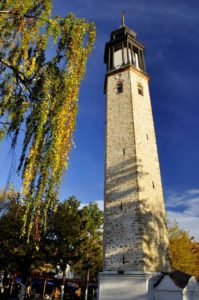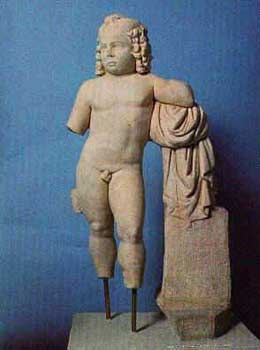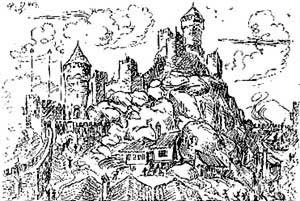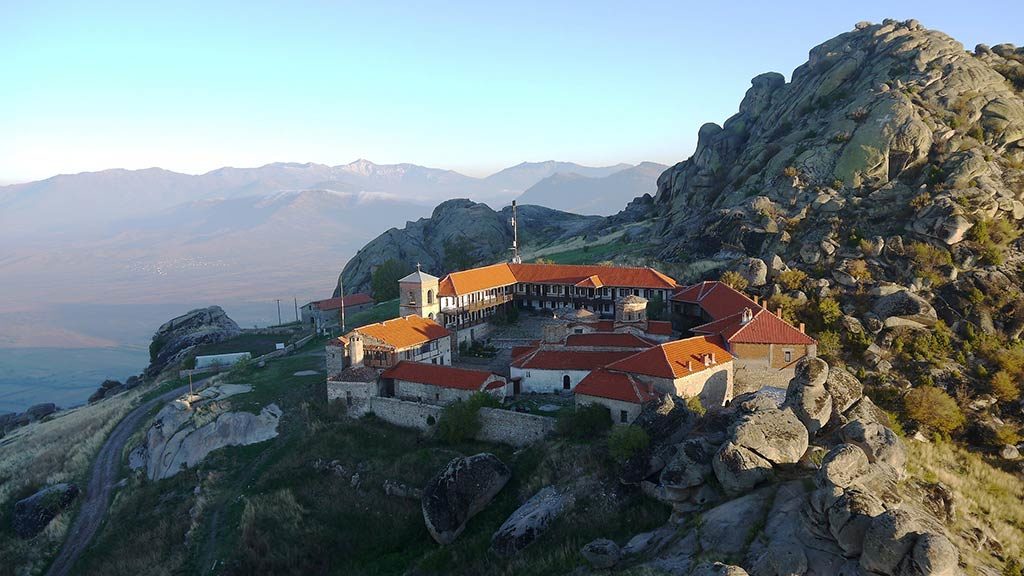Table of Contents
Prilep History
Prilep is situated in the northern part of Pelagonia Plain. It is often called “the city under Marko’s Towers” since the town is located on the skirts of the Towers of the legendary hero King Marko, who is common in Macedonian folk songs and tales as a powerful, wise ruler, and fighter against the Turks.
There are several ancient sites in the immediate vicinity including one at Markovi Kuli. A large Roman necropolis is known there and parts of numerous walls have been found; the settlement was probably the ancient Ceramiae mentioned in the Peutinger Table. Roman remains are also known in the vicinity of the Varosh monastery, built on the steep slopes of the hill, which was later inhabited by a mediaeval community. A large number of early Roman funeral monuments, some with sculpted reliefs of the deceased or of the Thracian Rider and other inscribed monuments of an official nature, are in the courtyard of the church below the southern slope of Varosh. Some of the larger of those monuments were built into the walls of the church.
The most important ancient monument is the old city of Styberra. It is situated on Bedem hill near Cepigovo, in the central region of Pelagonia. As early as the time of the Roman – Macedonian wars, this city was known as a base from which the Macedonian king Perseus set out to conquer the Penestian cities. Its location on a relatively small hill where the Diagonal Way from Heraclea to Stobi met the road that led along the River Erigon from the mining district of Demir Hisar, was conducive to its transformation into a significant conurbation during the Roman era. The activity of the city gymnasium particularly increased. The temple which has been excavated and which was dedicated to Tyche, the patron deity of the city, was partly “privatized” by sponsors who refurbished it in 127.
Styberra did not manage to survive the assaults of the Goths in 268. The city was never rebuilt, which is confirmed by the undamaged state of the objects found during archaeological excavations. Numerous marble statues, left behind by the Goths after they had ravaged the city, were found at this site. Because of its state of preservation, the city of Styberra became known as the Macedonian Pompeii. Analysis of the marble sculpture supports the theory that there was a local workshop which was active in the 2nd century and the first half of the 3rd. The products were of such quality that it challenged the dominance of the Stobi artists and craftsmen.
An important site in the vicinity is Bela Crkva, some 6 km west of Styberra, where the town of Alkomenai was probably located. Rebuilt in the Early Roman period, it was a stronghold of the Macedonian kings, perhaps from the time of Alexander the Great, and was at the Pelagonian entrance to a pass leading to Illyria. Part of the city wall, a gate, and a few buildings of the Roman period were uncovered here in excavations. All recent finds from these sites are in the Museum of the City of Prilep.
The monastery of Treskavec, in the mountains about 10 km north of Prilep, is probably the site of the early Roman town of Kolobaise. The site, at the edge of a small upland plain, is at a height of over 1100 m above sea level and is a natural citadel. The name of the early town is recorded on a long inscription on stone which deals with a local cult of Ephesian Artemis. The inscription was reused as a base for a cross on top of one of the church domes. Other inscriptions at Treskavec include several 1st century Roman dedications to Apollo.
The old fortress was used by the Romans, and later the Byzantines. During the Middle Ages, King Marko rebuilt the citadel extensively, making it an important military stronghold. After all, even Tsar Samoil came here after the defeat on Belasica in 1014. Samoil died in Prilep from a heart attack after encountering his blind soldiers.
Prilep Industry
The town is the largest and most famous center for the production of high-quality tobacco and cigarettes besides its metal processing, electronic, timber, textile, food, and marble industries.
Tobacco is one of the traditional crops which flourishes in the Macedonian climate. Many of the world largest cigarette makers use this tobacco to enrich the aroma and quality of their cigarettes. It is also being processed in local factories and it is the main cash crop in many small holdings. For that purpose, the Institute of Tobacco has been established in Prilep, with the purpose of generating new types of tobacco. This is the first example of employing genetics in the agriculture in the Balkans.
In addition to the tobacco, the Macedonian marble Sivec, found in the mountains surrounding Prilep, is also known worldwide for its strength and clean white appearance.
Prilep is important also in the cultural sense. For instance the Old Town’s architecture, as well as the architecture of the old marketplace, are both extremely attractive. The Institute of Old Slavic Culture is located in Prilep. Also, each year an International Art Colony is held here, as well as the Professional Theater Festival of Macedonia, honoring the first modern Macedonian playwright, Vojdan Chernodrinski, who was born in Prilep.
Several old monasteries are found in the town’s immediate vicinity, such is the Monastery of Treskavec, build in the 12th century with the frescoes dating from the 14th and 15th centuries. The Monastery of the Holy Archangel Michael (whose church has some 12th and 14th centuries frescoes) and the Monastery of Zrze (14th century) are also located near Prilep. The award winning Macedonian film “Before the Rain”, winner of the Venice’s Festival Golden Lion and Oscar nominee for 95, was filmed in Prilep’s vicinity.
Prilep is also a revolutionary town. It was here and in Kumanovo, when on October 11, 1941, the struggle of the Macedonian people against fascism begun. The Memorial of the Unconquered, honoring the victims of fascism is placed in the town’s spacious and beautiful park.
The School of Business, part of the St. Clement University of Bitola, is locataed in Prilep. Interestingly, the Macedonian currency bank-notes, the denar, is also printed in Prilep.
Prilep has 98,327 residents (1991), and it covers 1.675 sq. km.
Current weather in Prilep

Virtual Macedonia
Republic of Macedonia Home Page
Here at Virtual Macedonia, we love everything about our country, Republic of Macedonia. We focus on topics relating to travel to Macedonia, Macedonian history, Macedonian Language, Macedonian Culture. Our goal is to help people learn more about the "Jewel of the Balkans- Macedonia" - See more at our About Us page.
Leave a comment || Signup for email || Facebook |
History || Culture || Travel || Politics



















